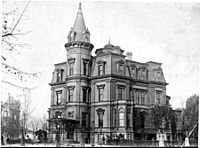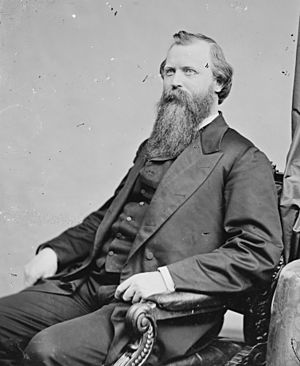Stewart's Castle facts for kids
Quick facts for kids Stewart's Castle |
|
|---|---|

Stewart's Castle
|
|
| Alternative names | Stewart's Folly Castle Stewart |
| General information | |
| Town or city | Washington, DC |
| Country | United-States |
| Coordinates | 38°54′37″N 77°02′39″W / 38.91029°N 77.04424°W |
| Completed | 1873 |
| Demolished | 1901 |
| Owner | Senator William Morris Stewart |
| Design and construction | |
| Architect | Adolf Cluss |
Stewart's Castle was a grand house in Washington, D.C.. It was also known as Castle Stewart or Stewart's Folly. The house was located near Dupont Circle. It got its names from its owner, Senator William Morris Stewart, and its castle-like look.
The building had towers and stood out in an area that was not very popular at the time. Architect Adolf Cluss designed the house. It was finished in 1873 but only stood for 28 years. A fire badly damaged it in 1879. Later, the house was repaired. The Chinese Legation rented it from 1886 to 1893. Senator William A. Clark bought the house and tore it down in 1901. He planned to build a new home, but it never happened. The land stayed empty for over 20 years. Today, a commercial building stands there.
Contents
A Look Back: The Castle's Story
Building a Grand Home
In the 1860s, the area around what is now Dupont Circle was mostly undeveloped. It was marshy land with only a few small houses. The city began making big improvements in 1871. The next year, Connecticut Avenue was paved. Trees were planted along the road. The circle itself, first called Pacific Circle, was improved with paths and landscaping.
The land developers were wealthy lawyers. They included Nevada Senator William Morris Stewart. They had made their money from mining in California and Nevada. These developers were sometimes called the Pacific Pool or California Syndicate.
Stewart's partners encouraged him to build a large house in Pacific Circle. They hoped it would help the area grow and make property values go up. Stewart decided to build his house. He chose Adolf Cluss as his architect. Cluss (1825-1905) was a German immigrant. He was the city's architect at the time. He designed many important buildings, like the Arts and Industries Building.
Construction of Stewart's Castle lasted from 1871 to 1873. It cost between $80,000 and $100,000. The house was nearly 19,000 sq ft (1,800 m2). Its unique shape came from the 16,322 sq ft (1,516.4 m2) lot it sat on. This lot was on the north side of the circle. Stewart's wife, Annie, bought all the furniture in France in 1872. The first shipment of furniture was lost at sea. So, they ordered almost the same things again, and those arrived safely.
Life Inside Stewart's Castle
When the five-story house was finished, people had mixed feelings. It was the first house built on the circle. Many thought it was one of the most fancy private homes in the city. Most people agreed it was impressive. They called it Stewart's Castle or Castle Stewart. This was because of its size and its grand, turreted front.
But some also called it Stewart's Folly. At the time, its location was far from the city's popular areas. There were very few houses nearby. Not many new homes were built for several years. This was due to a tough economic time called the Long Depression. It lasted from 1873 to 1879. It took seven years for another house to be built on the circle.
The Stewarts spent a lot of money building and furnishing the house. Senator Stewart had left his real estate group. Keeping up such a big house was very expensive. It included a stable with racehorses and many servants. But the Stewarts hosted big parties. Their house became a lively place for Washington, D.C. society. One reporter said going to a party there felt like being Marco Polo at the court of Kublai Khan.
In 1874, the fancy British Legation was built nearby. This made the area more popular. In 1875, after only two years in the house, Stewart and his family moved back to California. He needed to focus on his law and mining work. For the next four years, only a few servants and a watchman lived in the house.
The Fire of 1879
By 1879, Annie Stewart returned to Washington, D.C. She planned a New Year's Eve party at Stewart's Castle. But on December 30, a fire started. It was caused by a problem with the chimney. Annie was visiting friends when it happened. By the time firefighters arrived, the fire had spread.
Annie rushed back to find her house in flames. The British minister, Sir Edward Thornton, and his staff helped. They took Annie and her daughter to the British Legation. Her daughter had been sleeping upstairs and was saved by servants. Many items from the first and second floors were saved. These included paintings, furniture, and silver. But the upper floors were completely destroyed. The lower floors were also badly damaged. The damage cost about $50,000. The house was left empty until 1883. Then, Stewart hired architect Robert Isaac Fleming to oversee the big repairs.
The Chinese Legation's Home
The Stewarts tried to sell their house, but they could not. In 1886, they started renting Stewart's Castle to the Chinese Legation. It was rented fully furnished for $10,000 a year. When Stewart was reelected to the Senate in 1887, his family rented another house.
Chinese diplomats had been in Washington, D.C. for some years. But locals were still curious about them. Neighbors found some of their activities unusual. For example, staff would do laundry in Dupont Circle. They also played games at night. When staff went onto the castle's balconies, people would stare. Police sometimes had to ask the public to move along.
Getting an invitation to the Chinese Legation was special. Their parties were considered fashionable and unique. A local newspaper described one event. It said Washington ladies were happy to meet the new Chinese Minister's wife. She greeted them in her room. She walked on her small, bound feet. She wore beautiful silk robes.
In 1887, a party at the Chinese Legation caused a stir. About 400 invitations were sent out. But over 1,500 people came into the building. The local newspaper called it a "mob." Guests could not move for hours. Chinese decorations were broken or lost. Guests lost their coats. One senator was separated from his wife for over two hours.
The Chinese Legation rented Stewart's Castle until 1893. By then, Stewart was reelected to the Senate. The Legation had caused a lot of damage to the building. For example, staff cooked fish on the kitchen tile floors. They were not used to stoves. There were also smoke stains in rooms. This was because the minister would burn red peppers when he wanted guests to leave. Stewart asked the Chinese government for $15,000 for the damages. They settled on $3,000.
The Castle's Final Years
Stewart began to restore the house. This included repainting and redecorating the inside. He also repainted the outside and fixed holes in the walls. Annie and her youngest daughter returned from a trip with new furniture. The family rented another house until the repairs were done in late 1894. After the renovations, Stewart's Castle once again became a center of Washington, D.C. society.
The family lived in the house until September 1899. Then, wealthy Montana Senator William A. Clark bought it. He paid about $145,000. Stewart bought a new property. A few years after moving out, Stewart sold many of the castle's furnishings at an auction.
Senator Clark planned to build a large, new home on the site. But he faced a scandal. He was accused of wrongdoings related to his election. The U.S. Senate did not allow him to take his seat. Clark moved to New York. He never lived in Stewart's Castle. However, he sometimes allowed charity events to be held there. Clark was reelected to the Senate in 1901. Stewart's Castle was torn down that same year. Clark lived next door but never built a new home in the city. He focused on building a large house in New York instead.
For over 20 years, the land where Stewart's Castle stood was empty. It was overgrown with weeds. Only the foundation stones remained. In 1908, a church thought about buying the land. But Clark kept owning the empty lot. In December 1921, he sold it for over $200,000. A car showroom was built on part of the land. In 1922, Riggs Bank (now PNC Financial Services) built a branch next to the showroom. Later, Riggs Bank bought the showroom. The two buildings were combined in 1923.
In 1990, Riggs Bank announced plans to tear down the branch. They wanted to build a 10-story office building. But neighbors and people who wanted to save old buildings stopped the project. In 2015, PNC sold the property. But they signed a 15-year lease to keep their bank branch there. Other businesses like AT&T and Sweetgreen are also tenants.
Images for kids




